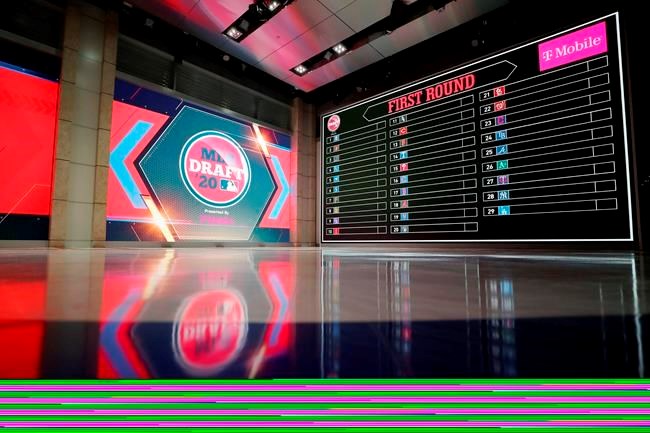NEW YORK — Spencer Torkelson slugged his way through college, bashing baseballs all around the country with eye-popping power.
All those impressive long balls made the decision easy for the Detroit Tigers, who made the Arizona State star the No. 1 pick in the Major League Baseball amateur draft Wednesday night.
While Torkelson was long considered the
Detroit plans to move Torkelson to the hot corner from first base, where he played in college.
“It shows the amount of respect they have for me as an athlete,” a smiling Torkelson said in an interview during the MLB Network broadcast. “I'll take it and run with it. I like to label myself as a baseball player, and you give me a bat, a ball and a glove, and you know what? I'm just going to want to win.”
Arkansas outfielder Heston Kjerstad went No. 2 overall to Baltimore, which took Oregon State catcher Adley Rutschman with the top pick a year ago.
After having the worst record in the majors last season, Detroit opened the draft for the second time in three years. The Tigers took Auburn right-hander Casey Mize in 2018, and now they’ve got a powerful bat that could anchor their lineup for years to come to go along with an arm they hope is a future ace.
With power to all fields and a great eye at the plate, the 6-foot-1, 220-pound Torkelson established himself as college baseball’s top slugger after going undrafted out of high school. He hit 54 home runs at Arizona State, two shy of the school record set by Bob Horner — who was drafted No. 1 overall in 1978.
Torkelson likely would have obliterated that mark if his college season hadn’t been
“We know he can play first. But our scouts strongly feel that he can play third base, and that’s out intent at this point,” Detroit general manager Al Avila said on the ESPN broadcast. “He’s exactly the type of player we hoped would be there for us to get with the top pick. Obviously, he’s one of the most productive hitters in college history.”
This year’s draft was originally scheduled to be held for the first time in Omaha, Nebraska, as a lead-in to the College World Series. Instead, the coronavirus pandemic caused baseball to make some drastic changes, including holding the draft as a remote event — much like the NFL did in April — and shortening it from three days with 40 rounds to just two days and five rounds.
Manfred announced the first-round selections from MLB Network studios in Secaucus, New Jersey, as he has done since taking over for Bud Selig in 2015. Manfred also addressed racial injustice and the recent protests that have taken place all around the country and the world. All 30 team representatives, operating remotely, held up signs at the beginning of the broadcast that read: “Black Lives Matter. United For Change.”
The shortened college and high school baseball seasons presented unique challenges for big league scouting departments, which had to rely more on videos of players instead of attending games to help with their evaluations.
Perhaps that contributed to a record seven straight college players being selected to begin the draft.
After Torkelson and Kjerstad were picked, Miami took Minnesota right-hander Max Meyer; Kansas City selected Texas A&M lefty Asa Lacy; Toronto went with Vanderbilt shortstop Austin Martin; Seattle chose Georgia righty Emerson Hancock; and Pittsburgh picked New Mexico State shortstop Nick Gonzales.
Tennessee high school outfielder Robert Hassell ended the run on college players, going No. 8 to San Diego. That’s the latest the first prep player was taken in a draft, surpassing Clayton Kershaw, who went to the Dodgers at No. 7 in 2006.
Florida high school outfielder Zac Veen was taken by Colorado with the ninth pick, followed by the Los Angeles Angels selecting Louisville lefty Reid Detmers to round out the top 10.
The Tigers’ selection of Torkelson also marked the second straight year a college position player was taken with the first pick. It’s the first time that has happened since Milwaukee took North Carolina catcher B.J. Surhoff in 1985 and Pittsburgh selected Arkansas third baseman Jeff King a year later.
“He’s one of the most polished hitters we’ve seen in the draft for quite some time, showing plus-plus power and excellent plate discipline," Tigers director of amateur scouting Scott Pleis said in a statement. "We’ve been tracking Spencer’s growth and performance since his breakout freshman season at Arizona State, and are excited to see him grow in the coming years.”
The first round of the draft will be completed, along with eight competitive balance round selections, on Wednesday night — 37 picks in all. Rounds 2-5 will be held Thursday night, for a total of 160 players selected.
Undrafted players will need to wait until Sunday before they can sign with major league teams, who can offer signing bonuses only up to $20,000 as agreed upon by Major League Baseball and the players’ association. That could prompt many players to instead go back to school or junior college and be eligible again for the draft next year — when big league teams can cap it at 20 rounds if they choose.
Houston will have to wait a while before it makes its first picks after being stripped of its first- and second-round selections by Manfred as part of the team’s punishment for breaking rules against using electronics to steal signs during games. The Astros get started with pick No. 72, which they received as compensation for the loss of pitcher Gerrit Cole, who signed as a free agent with the New York Yankees.
Boston lost its second-round pick for violating rules against in-game use of video to identify pitch signals.
___
More AP MLB: https://apnews.com/MLB and https://twitter.com/AP_Sports
Dennis Waszak Jr., The Associated Press



